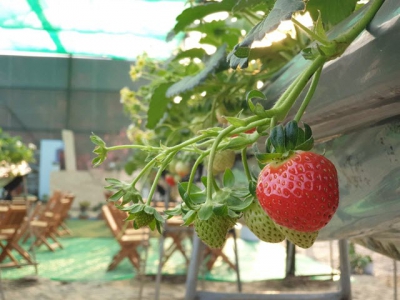Strawberry farm in Hà Nội - evidence of potential farm tourism

HÀ NỘI — The west bank of the Hồng (Red) River in Hà Nội’s Tây Hồ District is famous for its traditional flower villages – Tứ Liên, Nhật Tân, Quảng An and Phú Thượng.
Strawberry plants at the Chimi farm. — VNS Photo Bích Hường
Trees used to celebrate the Tết (Lunar New Year) holiday such as the peach trees grown in Nhật Tân and kumquat trees grown in Tứ Liên are said to be the best in town.
For over a decade, flower farms have been open for visitors who want to enjoy the spectacle, take photos or just breathe the fresh air in the otherwise crowded city.
“That is the reason why we opened a strawberry farm at the heart of Nhật Tân flower village,” Nguyễn An Phương, sales manager at Chimi Farm Hà Nội, said.
The 3,000 sq.m strawberry farm opened last December and for the last few months, it has attracted young people and families looking for a new farming experience in the city.
The first crop of the temperate fruit grown by Chimi Farm Hà Nội is in the process of being harvested.
The farm supplies strawberries for stores and supermarkets in the city, and they’re also available for visitors.
Phương said that visitors can learn how to nurse the strawberry plants, pick fruit and make strawberry yogurt and other drinks.
“They can enjoy the drinks at the cafe on the farm,” Phương added.
“Taking photos is free of charge. You pay for the fruit you pick and the drinks,” Phương said.
It’s about VNĐ 350,000 (US$15) per kilo of strawberries picked at the farm.
The farm also offers young plants for VNĐ40,000 with instructions on how to tend to them.
Hoàng Phương Thảo from Hà Nội’s Hoàn Kiếm District said her children really enjoyed the farm.
“They got excited about looking for ripe red strawberries and picking them,” Thảo said, adding that the kids burst into laughter whenever they found an odd-shaped fruit or a worm under the leaves.
“The children and I had a good time at the farm as they got to play outdoors and get closer to nature,” Thảo said.
She said they would visit the farm again because it was close to their house.
Phương said the excitement had sparked an idea about farming tourism.
He said he had travelled a lot with friends and enjoyed great experiences during trips across Việt Nam, one of the best of which was picking strawberries at farms in the Central Highland city of Đà Lạt.
“A friend of mine, Vũ Văn Lực, has always dreamed about starting a strawberry farm since he was a student at the National Economics University,” Phương said.
After graduating in 2013, Lực went to Đà Lạt to learn about strawberry farming.
Lực and two other friends were the first to inspire Phương to start a strawberry farm.
After learning about the farm tour model as well as farming techniques, Phương said they decided to bring the fruit to his northern province of Sơn La as the weather there is similar to Đà Lạt.
“But it was not easy. Most of the 4,000 sq.m of strawberries that Lực planted in Sơn La’s Mộc Châu Plateau in 2014 died,” Phương said, forcing them to improve their technique and soil so the plants could adapt better in the northern province.
In 2015, Lực opened Chimi Farm covering one hectare in Bản Áng Hamlet, Đông Sang Commune, Mộc Châu Town. The farm was expanded to 6ha last year, offering both fruit and tourism services.
“Chimi Farm Hà Nội is a branch of Chimi Farm Mộc Châu, which was established to promote Chimi Farm’s strawberries, making the fruit more accessible to consumers in Hà Nội and neighbouring provinces,” Phương said.
Many visitors to Chimi Farm Mộc Châu asked if they could find a similar farm in Hà Nội and we thought, “Why not?”
“Opening a strawberry farm in Hà Nội was a challenge for us,” Phương said, adding that they had to study the weather, soil and techniques to ensure the plants could adapt.
Winter and spring in Hà Nội when the temperature hit 14-28 degrees Celsius are good for strawberries. The plants produce fruit in hot weather. It takes about 2.5 -3 months for the fruit to grow, ripen and be harvested. At Chimi farms, the strawberries are organic without any chemical fertilisers.
Phương said people preferred Chimi strawberries because they understood organic farming and could pick the fruit themselves, “which seemingly adds taste to the fruit”.
Phương said that they planned to expand the farm tourism model to Sa Pa and another farm in Hà Nội.
"Among the city’s concrete jungle, chaotic traffic, crowded streets and domination of automatic technology devices, the availability of farms and manual farm work bring people joy," Phương said.
Related news
 Garlic harvest in Ly Son Island fails due to drought
Garlic harvest in Ly Son Island fails due to drought Farmers in the island district of Ly Son have entered the harvest time of the winter-spring garlic crop these days but they have a poor crop due to prolonged
 Optimising conservation farming with technology
Optimising conservation farming with technology Conservation farming is aimed at conserving soil and water resources, and uses a number of techniques: crop rotation, minimum tillage, retaining of soil residue
 Pepper farmers get into debt because of diseases, low prices
Pepper farmers get into debt because of diseases, low prices Pepper used to be considered as black gold as it brought prosperity to farmers in the Central Highlands of Vietnam but in recent years pepper plants